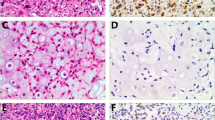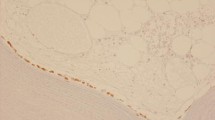Abstract
Immunohistochemical staining of osteosarcoma specimens was performed with anti-proliferating cell nuclear antigen (PCNA) monoclonal antibody (PC10, Novocastra) and anti-p53 antibody (DO7, DAKO), using the streptavidinbiotin (SAB) method. The average PCNA labeling index was 55.3% and all patients with a labeling index higher than 68% died of diesease. p53 expression was 40.9% and the labeling index was 33.3% in patients who were continuously disease-free, but the index was 37.9% (average) in patients who died of disease; all patients with an index higher than 50% died of disese. However, in patients with metastasis, the p53 index was low in patients who survived after resection of the metastasis, suggesting that this profile may reflect the metastatic behavior of the tumor. We often perform preoperative chemotherapy for osteosarcoma and we consider that markers of the effect of chemotherapy are important in predicting survival. It seems that an increase in the PCNA labeling index and an increase in the p53 labeling index or in p53 expression after chemotherapy indicates a good prognosis.
Similar content being viewed by others
References
Baker SJ, Preisinger AC, Jessup JM et al. p53 gene mutations occur in combination with 17p allelic delections as late events in colorectal tumorigenesis. Cancer Res 1990;50:7717–22.
Chano T, Matsumoto K, Ishizawa M, et al. Periosteal osteosarcoma and parosteal chondrosarcoma evaluated by double immunohistochemical staining. Acta Orthop Scand 1994;65:355–8.
Deb S, Jackson CT, Subler MA, et al. Modulation of cellular and viral promoters by mutant human p53 proteins found in tumor cells. J Virol 1992;66:6164–70.
Dreinhöfer KE, Åkerman M, Willén H, et al. The proliferating cell nuclear antigen (PCNA) in high-grade malignant fibrous histiocytoma: Prognostic value in 48 patients. Int J Cancer 1994;59:379–82.
Gannon JV, Greaves R, Iggo R, et al. Activating mutation in p53 produces a common conformational effect. A monoclonal antibody specific for the mutant form. EMBO J 1990;9:1595–602.
Gelb AB, Kamel OW, LeBrun DP, et al. Estimation of tumor growth fractions in archival formalin-fixed, paraffin-embedded tissues using two anti-PCNA/cyclin monoclonal antibodies. Am J Pathol 1992;141:1453–58.
Jain S, Filipe MI, Hall PA, et al. Prognostic value of the proliferating cell nuclear antigen (PCNA) in gastric carcinoma. J Clin Pathol 1991;44:655–9.
Levine AJ, Momand J, Finlay CA. The p53 tumor suppresser gene. Nature 1991;351:453–6.
Masuda H, Miller C, Koeffler HP, et al. Rearrangement ofp53 gene in human osteogenic sarcomas. Proc Natl Acad Sci USA 1987;84:7716–9.
Mathews MB, Bernstein RM, Franza Jr BR, et al. Identity of the proliferating cell nuclear antigen and cyclin. Nature 1984;309:374–6.
Matsuoka S, Yamaguchi M, Hayashi Y, et al. Nucleotide sequence and promoter-specific effect of a negative regulatory region located upstream of the mouse proliferating cell nuclear antigen gene. Eur J Biochem 1993;218:173–81.
Michie BA, Black C, Reid RP, et al. Image analysis-derived ploidy and proliferation indices in soft tissue sarcomas: Comparison with clinical outcome. J Clin Pathol 1994;47:443–7.
Miller CW, Aslo A, Tsay C, et al. Frequency and structure of p53 rearrangements in human osteosarcoma. Cancer Res 1990;50:7950–4.
Nishikawa T, Yamamoto T, Mizuno K, et al. Expression of the p53 protein in human osteosarcoma J Jpn Orthop Assoc 1994;68:400–6.
Numata S, Yamashita T, Ishii S, et al. Moderation of growth and transformation of murine MC3T3-E1 cell line by murine wild-type and mutant p53 genes. Tumor Res 1991;26:43–53.
Prelich G, Tan C-K, Kostura M, et al. Functional identity of proliferating cell nuclear antigen and a DNA polymerase-δ auxiliary protein. Nature 1987;326:517–20.
Robbins BA, de la Vega D, Ogata K, et al. Immunohistochemical detection of proliferating cell nuclear antigen in solid human malignancies. Arch Pathol Lab Med 1987;111:841–5.
Sakayama K, Masuno H, Miyazaki T, et al. Existence of lipoprotein lipase in human sarcomas and carcinomas. Jpn J Cancer Res 1994;85:515–21.
Sasaki K, Kurose A, Ishida Y, et al. Flow cytometric analysis of the expression of PCNA during the cell cycle in HeLa cells and effects of the inhibition of DNA synthesis on it. Cytometry 1993;14:876–82.
Sasaki K, Kurose A, Ishida Y, et al. Estimation of S-phase fraction in tumor tissue sections by immunohistochemical staining of PCNA. J Histochem Cytochem 1994;42:957–60.
Sasaki K, Kurose A, Shibata Y, et al. Varying detection of PCNA in solid tumor cells: Effect of fixation and detergent. J Histotechnol 1995;18:31–4.
Shivji MKK, Kenny MK, Wood RD. Proliferating cell nuclear antigen is required for DNA excision repair. Cell 1992;69:367–74.
Sugiura H, Satoh K, Yamamura S. Prognostic factors in soft tissue MFH. J Jpn Orthop Assoc 1994;68:S1090.
Takamoto S, Ohta K. Mechanism of action of anticancer agents by flow microfluorometry. Jpn J Cancer Chemother 1978;51:727–36.
The JOA Musculo-skeletal comittee. General Rules for Clinical and pathological studies on Malignant Bone Tumors. 2nd ed. Tokyo: Kanehara, 1990:47–54.
Toguchida J, Ishizaki K, Sasaki M, et al. Chromosomal reorganization for the expression of recessive mutation of retinoblastoma susceptibility gene in the development of osteosarcoma. Cancer Res 1988;48:3939–43.
Toguchida J, Ishizaki K, Nakamura Y, et al. Assignment of common allele loss in osteosarcoma to the subregion 17p13. Cancer Res 1989;49:6247–51.
Toschi L, Bravo R. Changes in cyclin/proliferating cell nuclear antigen distribution during DNA repair synthesis. J Cell Biol 1988;107:1623–8.
Wadayama B, Toguchida J, Yamaguchi T, et al. p53 expression and its relationship to DNA alterations in bone and soft tissue sarcomas. Br J Cancer 1993;68:1134–9.
Waseem NH, Lane DP. Monoclonal antibody analysis of the proliferating cell nuclear antigen (PCNA). J Cell Sci 1990;96: 121–9.
Zeman EM, Calkins DP, Cline JM, et al. The relationship between proliferative and oxygenation status in spontaneous canine tumors. Int J Radiat Oncol Biol Phys 1993;27:891–8.
Author information
Authors and Affiliations
About this article
Cite this article
Shiraishi, H., Kotake, T. Usefulness of PCNA labeling index and p53 expression in determining prognosis in osteosarcoma. J Orthop Sci 2, 57–63 (1997). https://doi.org/10.1007/BF02489514
Received:
Accepted:
Issue Date:
DOI: https://doi.org/10.1007/BF02489514




